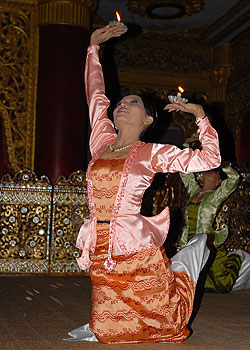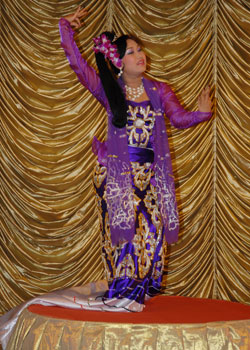Zat; story: pwe; show: zat-pwe; Myanmar musical play: mintha; male lead: minthami; female lead: ngo-gyin; wailing song: nha-par-thwar. duet dance and song: lun-khan. tragic scene. There is no nation on the face of the earth so fond of fun and laughter and theatrical entertainment as the Myanmar. For a Myanmar. from the moment he is pushed into the world. his first wah-wah is accompanied by saing (music of the orchestra played to celebrate any event). and throughout his life’s journey. everything that happens to him. or everything he does is accompanied by saing; this goes on. until he leaves the world with saing playing the dolorous note of the Monkey King’s Lament that being the title of the fu-neral music.


Without the benefit of saing is a popular Myanmar idiom to describe any dull. uninteresting event or something unceremonious or unheralded. A person arriving without any previous notice is often remarked upon as arriving without the benefit of saing.The art of Myanmar zat-pwe is one of the subtlest and most elusive of arts and trying to explan it is like capturing a moon beam to analyze its power over lovers and poets.
Zat-pwe is deeply rooted in the traditions of the country and has many conventions which are not easily understood by a casual spectator. Myanmar’s monarchical pass has given the zat-pwe the glorious music and songs as well as court dramas of great poetic beauty. Most of the zats (stories or plots) are drawn from Buddhist scriptures and from there. the zat artistes draw their inspiration and help to interpret to the laymen the Buddhist thought the way of life.
Since the elements of the opera. ballet and musical are woven into the zat-pwe. the whole thing is a wonderful piece created by the teamwork of artistes; but the artistes themselves are fiercely individualistic. each expressing himself or herself with such freedom that it makes you marvel at the spontaneous coordination that is finally achieved.
Because of its individual style. that is characteristic of the Myanmar. we cannot look at zat-pwe through coloured spectacles of foreign manufacture….which mistake I made. when I viewed it with eyes dimmed by half-baked ideas I had gathered. after scanning through ancient Greek dramas. Shakespeare and modern English plays for the purpose of passing an examination.


In those days I had so much to say about zat conventions and practices; “There is no classification of tragedy and comedy. it lacks realism. no proper attention is given to the plot. the scenes are long drawn-out. there is no unity of time or space. There’s the nha-par-thwar scene. with one mintha and six or eight minthamis singing and dancing; it’s hardly decent. because it is like flinging the mintha’s Cassanova activities in the public’s face. As for lun-khan why should there be ngo-gyins (wailin songs) enough to make us a nation of pessimists? … et cetera. et cetera. Yes. there was a time when I said all these and much more.”
Today. I take back all the things I had said and I feel both humble and happy in the realization that I had been blind to the beauties of the zat-pwe which I recently discovered after thirty years of turning my impertinent back upon the traditional Myanmar entertainment. Today. zat-pwe is still misinterpreted and much injustice is being done to it in futile attempts to evict decadent influences that are as natural as weeds in a flower garden. One cannot be too careful not to injure the blooms in pruning away the undesirable under-growths.
Nha-par-thwar scene in the old days used to be a duet. dancing and singing. with one mintha and one minthami. Later. probably to meet the demands of the audience. the artistes introduced new attractions. hence one mintha with many minthamis in the scene. The dancing and singing of each minthami in nha-par-thwar scene symbolize different facets of feminine charm and the mintha responds with varying moods to match each act. One of the arts of’a mintha is part of nha-par-thwar. not only has he to do the duet dance and sing. he must also have subtle artistry in reciprocating the infinite variety of his minthamis.
The nha-par-thwar scene in the hands of a consummate artist blossoms forth as a thing of beauty. but when a lesser performer enacts it. it becomes nothing but a vulgar sham. a Cassanova shamelessly flaunting his amours and bringing out the worst side of man’s baser instincts. Ngo-gyins(wm\’mg songs) used to worry me a lot: “There are too many of them in zat-pwes enough to drive the whole country mad; we shall become a nation of pessimists…” Now I realise all that kind of high and mighty talk is nothing but a pose. a wiser-than-thou attitude acquired through having a smattering of education; for when Daw Ah Mar’s book on the three great minthas. Aung-ba-la. Po Sein. Sein-ga-done came out complete with texts of ngogyins sung by the great three. I found myself warbling the half-forgotten airs of my youngers days to the astonishment of my family. Only then did I remember how I had enjoyed them both at zat-pwe and on the discs played on the trusty gramophone. fitted with a fluted horn.
I have discovered that ngo-gyin is not a dolorous Wailing song as it titcmRu suggests. Zat-pwe being partly operatic. most of the dialogue is wholly or party sung to music of the orchestra and ngo-gyin is somewhat. if not wholly. similar to the arias of the western operas. Ngo-gyins are sung both as soliloquies and also in dialogue and they are sung to express lyrical emotion. The histrionic and singing art of ngo-gyin deserves a comprehensive treatment with reference to texts sung by great artistes. arH with the help of Daw Ah Mar’s book and colourful snippets I managed to pick up from my recent rediscovery through seeing Shwe-Mahn Tin Maung’s zat-pwe. I hope to present the art of ngo-gyin more fuily some day.
Suffice it to say for the present that the art of ngo-gyin. like that of nha-par-thwar. needs a really accomplished artist to bring out its beauties. One of the many mistakes I made in assessing zat-pwe is that I deplored the lack of realism. which I now realise is a stupid thing; for. who wants realism in the fantastic world of makebelieve created by dance. song and music? If I was not prepared to be transported into a realm of’suspension of disbelief I should not have gone to a. zat-pwe in the first place. I should rather be left to wallow in the slime of realities that life has to offer in abundance. today. or any day.
Zat-pwe is thoroughly Myanmar. very much in keeping with the national character. and I hope I shall ever be Myanmar enough to enjoy its beauties that custom cannot stale. I hope I shall never be such a dull piece of goods. that the stirring music of nat-chin. the music of the nat-ka-daw dance which usually opens a zat-pwe fails to make my heart beat to its tune. I pray that I may never have a soul so dead that the dance of the belus. zawgyis. and nagas fails to fill me with a sences of wonder and insight into human aspirations symbolized by these mythical creatures.
